HAND PROTECTION - Standards Requirements
USafety has a protective glove for every industry and task. New advances in technology present new ways we can damage our hands, yet it also provides new materials to improve the efficiency of the gloves available. Our Research and Development team has developed gloves that meet the exacting standards of specialized industries such as chemical, food handling, medical, mining and welding as well as general manual handling protection. To ensure the best protection for USafety glove users, our gloves meet the appropriate specifications for each industry of use.
USAFETY has a protective glove for every industry and task. New advances in technology present new ways we can damage our hands, yet it also provides new materials to improve the efficiency of the gloves available. Our Research and Development team has developed gloves that meet the exacting standards of specialised industries such as chemical, food handling, medical, mining and welding as well as general manual handling protection. To ensure the best protection for USAFETY glove users, our gloves meet the appropriate specifications for each industry of use.
What are the USAFETY occupational protective gloves standards?
For hand protection, there is no ANSI standard for gloves but USAFETY recommends that selection be based upon the tasks to be performed and the performance and construction characteristics of the glove material. For protection against chemicals, glove must be based on the chemicals encountered, the chemical resistance and the physical properties of the glove material.
Do USAFETY gloves meet European Standards too?
 USAFETY has developed its glove range to meet industry requirements and standards. Most of the gloves we sell comply with European Standards. Where applicable, each of USAFETY’s gloves is assessed across a range of criteria for their specified usage for each standard. Each glove is given a performance rating for a number of factors against the specified usage. The usage is denoted by a pictogram. The individual glove’s performance rating is shown under the pictogram with a series of numbers or ratings. Each of the standards is explained in further detail.
USAFETY has developed its glove range to meet industry requirements and standards. Most of the gloves we sell comply with European Standards. Where applicable, each of USAFETY’s gloves is assessed across a range of criteria for their specified usage for each standard. Each glove is given a performance rating for a number of factors against the specified usage. The usage is denoted by a pictogram. The individual glove’s performance rating is shown under the pictogram with a series of numbers or ratings. Each of the standards is explained in further detail.
The following are the common categories of standards:

This is the pictogram for Mechanical Risks

EN420 - General Occupational Protective Standards
To achieve a standard, gloves must meet minimum performance levels for the following:

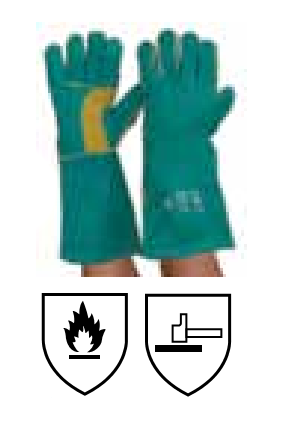 This Standard specifies the requirements and test methods for gloves used for manual welding of metals, cutting and related techniques. The welder’s gloves are classified into two categories.
This Standard specifies the requirements and test methods for gloves used for manual welding of metals, cutting and related techniques. The welder’s gloves are classified into two categories.
Type A indicates gloves that must provide a slightly higher degree of protection against heat.
Type B indicates gloves that must provide a slightly lower degree of protection against heat, but which have higher flexibility and versatility.
EN374-3 - Chemical Risk Standards
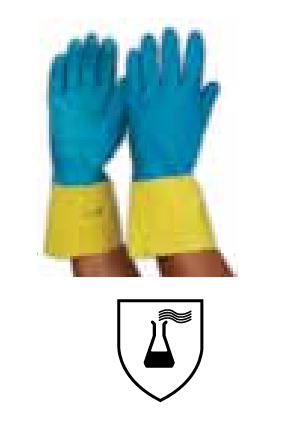 The standard specifies the determination of the resistance of protective glove materials to permeation by potentially hazardous non-gaseous chemical under constant contact. The glove must have a breakthrough time of at least 30 minutes or performance level 2 on the table below when tested against 3 chemicals from a list of 12 standard defined chemicals as listed in the table below. These 12 chemicals are specially selected as being those most commonly used in industry. The chemicals tested against are designated by an identifying letter from A to L.
The standard specifies the determination of the resistance of protective glove materials to permeation by potentially hazardous non-gaseous chemical under constant contact. The glove must have a breakthrough time of at least 30 minutes or performance level 2 on the table below when tested against 3 chemicals from a list of 12 standard defined chemicals as listed in the table below. These 12 chemicals are specially selected as being those most commonly used in industry. The chemicals tested against are designated by an identifying letter from A to L.


EN511 - Protection from Cold Standards
This standard applies to any gloves to protect the hands against convective and contact cold down to –50 °C.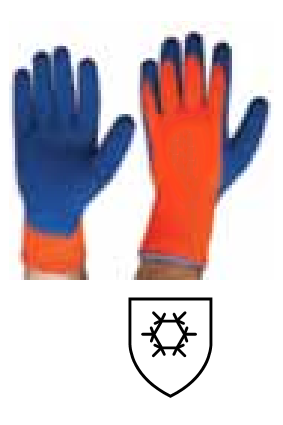
Two effects are measured with the glove:
Resistance to convective cold - based on the thermal insulation properties of the glove which are obtained by measuring the transfer of cold via convection.
Resistance to contact cold - based on thethermal resistance of the glove material when exposed to contact with a cold object.
The last digit next to the pictogram shows if water penetrates the glove after 30 minutes. The pictogram will be accompanied by a 3-digit code
Mechanical risk is the risk caused by abrasion, blade cut, tear and puncture to the wearer of the glove. Every glove is tested for its resistance against each of these risks and is given a rating for each.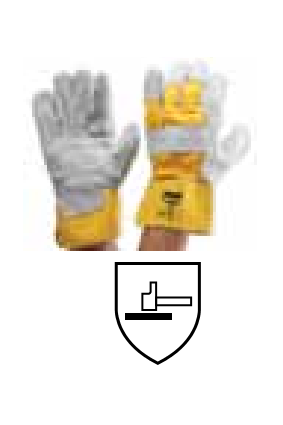
The higher the rating (5 being maximum), the better the performance of the glove against the risk.

The performance ratings are displayed below the Mechanical Risk pictogram.
EN407 - Thermal Risk Standards
This standard specifies test methods, general requirements, thermal performance levels and the marking of protective gloves against heat and/or fire. It is applicable to all the gloves which must protect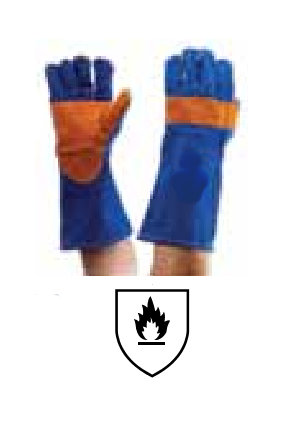 hands against heat and/or flames under one or several of the following forms: fire, contact heat, convective heat, small projections of molten metal or big projections of molten metal. Testing can be only carried out for performance levels and not for protection ones. The following table shows how the gloves are tested and given a performance rating.
hands against heat and/or flames under one or several of the following forms: fire, contact heat, convective heat, small projections of molten metal or big projections of molten metal. Testing can be only carried out for performance levels and not for protection ones. The following table shows how the gloves are tested and given a performance rating.

What are the USAFETY occupational protective gloves standards?
For hand protection, there is no ANSI standard for gloves but USAFETY recommends that selection be based upon the tasks to be performed and the performance and construction characteristics of the glove material. For protection against chemicals, glove must be based on the chemicals encountered, the chemical resistance and the physical properties of the glove material.
Do USAFETY gloves meet European Standards too?
The following are the common categories of standards:
This is the pictogram for Mechanical Risks
EN420 - General Occupational Protective Standards
To achieve a standard, gloves must meet minimum performance levels for the following:
- Clear manufacturer identification, product and size marking
- Innocuousness (e.g.: pH of the materials is neutral) and will not harm the health of the user
- Respect of agreed sizes (see the following size measurements table)
- Dexterity: it is advisable that a glove allows as much dexterity as possible according to the intended use
- Glove composition - any seams present in the construction of the glove do not result in a significant decrease in product performance.
- Packing, storage, maintenance and cleaning
- Information to the user on instruction for use whatever the PPE category: performances, pictograms, uses, use precautions, available size range.
 This Standard specifies the requirements and test methods for gloves used for manual welding of metals, cutting and related techniques. The welder’s gloves are classified into two categories.
This Standard specifies the requirements and test methods for gloves used for manual welding of metals, cutting and related techniques. The welder’s gloves are classified into two categories. Type A indicates gloves that must provide a slightly higher degree of protection against heat.
Type B indicates gloves that must provide a slightly lower degree of protection against heat, but which have higher flexibility and versatility.
EN374-3 - Chemical Risk Standards
 The standard specifies the determination of the resistance of protective glove materials to permeation by potentially hazardous non-gaseous chemical under constant contact. The glove must have a breakthrough time of at least 30 minutes or performance level 2 on the table below when tested against 3 chemicals from a list of 12 standard defined chemicals as listed in the table below. These 12 chemicals are specially selected as being those most commonly used in industry. The chemicals tested against are designated by an identifying letter from A to L.
The standard specifies the determination of the resistance of protective glove materials to permeation by potentially hazardous non-gaseous chemical under constant contact. The glove must have a breakthrough time of at least 30 minutes or performance level 2 on the table below when tested against 3 chemicals from a list of 12 standard defined chemicals as listed in the table below. These 12 chemicals are specially selected as being those most commonly used in industry. The chemicals tested against are designated by an identifying letter from A to L. EN511 - Protection from Cold Standards
This standard applies to any gloves to protect the hands against convective and contact cold down to –50 °C.

Two effects are measured with the glove:
Resistance to convective cold - based on the thermal insulation properties of the glove which are obtained by measuring the transfer of cold via convection.
Resistance to contact cold - based on thethermal resistance of the glove material when exposed to contact with a cold object.
The last digit next to the pictogram shows if water penetrates the glove after 30 minutes. The pictogram will be accompanied by a 3-digit code
- The first digit show resistance to convective cold (performance level 0-4)
- The second digit show resistance to contact cold (performance level 0-4). The higher performance level the better insulating capacity.
- The third digit show permeability to water (performance level 0 or 1) 0 = water penetration after 30 minutes, 1 = no water penetration after 30 minutes.
Mechanical risk is the risk caused by abrasion, blade cut, tear and puncture to the wearer of the glove. Every glove is tested for its resistance against each of these risks and is given a rating for each.

The higher the rating (5 being maximum), the better the performance of the glove against the risk.
The performance ratings are displayed below the Mechanical Risk pictogram.
EN407 - Thermal Risk Standards
This standard specifies test methods, general requirements, thermal performance levels and the marking of protective gloves against heat and/or fire. It is applicable to all the gloves which must protect
 hands against heat and/or flames under one or several of the following forms: fire, contact heat, convective heat, small projections of molten metal or big projections of molten metal. Testing can be only carried out for performance levels and not for protection ones. The following table shows how the gloves are tested and given a performance rating.
hands against heat and/or flames under one or several of the following forms: fire, contact heat, convective heat, small projections of molten metal or big projections of molten metal. Testing can be only carried out for performance levels and not for protection ones. The following table shows how the gloves are tested and given a performance rating.Source: Prochoice
Newer articles
Older articles
© Copyright by USAFETY CO.LLC.